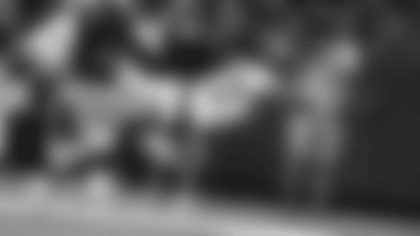Q. In your assessment of the game in Miami, you said that it took your defense some time to acclimate and get a feel for what was an unfamiliar group of players, one of whom was, as you described him, "a left-handed quarterback and some of the things they do." What were you referring to in terms of a left-handed quarterback and some of the things they do?
A. Just the things that happen offensively with a left-handed quarterback. A lot of the misdirection passes are to the defense's right, their strong-side route combinations are to the defense's right, and so the defensive right cornerback, and people like him, or the defensive right end or the defensive right outside linebacker, were seeing things that normally left cornerbacks and left edge players see. And so, it probably takes a little time to get acclimated to that and to understand that. And that's just football, to replicate some of those skills and talent, sometimes quarterback mobility in the form of a left-hander, there's just scarcity of that talent combination, and sometimes it takes an in-stadium experience to get acclimated to the realities of it.
Q. Another point you made is that "we've got to get more pressure on the quarterback." What qualifies as pressure?
A. Making them operate in an uncomfortable circumstance. It's not sacks, and I just wanted to make that point. The function of Miami's offense kind of reduces the potential for sacks. Everything is RPO (run-pass option) and misdirection passes and changing of the launch point, and so you understand it from that component. But the pressure component is about being disruptive, not allowing the offense to function in a normal pace that makes them comfortable. And that's about beating blocks and beating blocks quickly and affecting the normal flow of the offense.
Q. In determining pressure, do you put a stopwatch to it?
A. It depends on the play concept. If it's a play-action pass, quarterbacks will hold the ball from 3.25 to 3.75 seconds, and so the standard of disruption under that scenario is different than the standard of disruption if they're throwing rhythm, quick-passing, or rollouts and things of that nature. It's more than just beating the guy; it's about having an intelligent rush, and you understand the components of their attack, and to rush accordingly. Pressure sometimes vs. rhythm passing is just being aware that they're in a rhythm passing situation and you've got your hands up and you're batting balls down, or you're making the quarterback try to find a throwing lane in between the hands that are in the air, and then maybe someone else gets home. And so, that's what I mean when I'm talking about pressure. Pressure comes in many forms, and it's not just putting a quarterback on his back.
Q. When you're going against a running/mobile quarterback, does the definition of pressure change?
A. No question, because most of the time with a running quarterback comes different forms of offense. Misdirection passes, getting them on the perimeter, changing the launch point. Those are things that come with mobility, and so oftentimes, it is one in the same in terms of the discussion.
Q. A term used often in football these days is "chunk plays." What qualifies as a chunk play?
A. I think the global definition is a 10-plus-yard run and a 20-plus-yard pass. If you look at it analytically speaking, all the scouting services and things of that nature, I think it's becoming global to define those plays as runs of 10-yards or more and passes of 20-yards or more.
Q. OK, so beside fast receivers running deep down the field and the quarterback throwing a long pass, how are chunk plays created?
A. Run-after. Guys winning individual matchups and getting chunks of space after (the catch) is probably the more probable and the more consistent way that those plays are made. A guy breaks a tackle, a guy makes a routine play, breaks a tackle and tacks on 10 or 12 more yards, and that's quietly a chunk play, a field-flipping play, a play that changes the trajectory of the game because of the field position component of it.
Q. So that's just something that is happenstance, whether a receiver makes a defender miss, or a defender misses a tackle on his own?
A. I wouldn't call it happenstance. It's the game. You want guys on defense who can make open grass tackles. You want guys on offense who can make people miss under those circumstances. There's value in that, and there's nothing mystical about it. It's very tangible.
Q. In terms of a basic job description, what are the qualities the NFL expects of punters when it comes to location, distance, and hang-time, and then holding for the placekicker?
A. You know, 4.5 seconds and 45 yards is kind of a global standard of varsity, but the things that define quality punting is the situational punting. Guys who are consistently capable of putting the ball inside the 10-yard line without the ball going into the end zone; guys who can directional punt and keep a dangerous returner at bay by making the returner cover horizontal distances to field the ball, and at other times, you might need to eliminate the potential of a return. Maybe you punt the ball, and you get a penalty and you have to re-punt, and you've got a fatigued punt coverage group. Well, you want a punter who can put that ball 40 yards down the field and angle it out of bounds, which is all net yardage under those circumstances. And so, forget the yardage as a standard. All the guys who are serious candidates to be NFL kickers can meet that 4.5-second and 45-yard standard. It's the specialization, it's those moments and being able to deliver in those moments. That's the difference between being an NFL punter and being an aspiring NFL punter.
Q. When it comes to location, how fine do you cut the location aspect?
A. Very fine.
Q. Give me an example?
A. On the numbers, on the sideline, inside the 10-yard line but not in the end zone. Very fine.
Q. Do you coordinate your coverage with the way you tell the punter to kick the ball?
A. Every single kick and not just our unit. That's a global deal. That's just NFL football. Every single kick that's directional has a coordinated coverage associated with it, and that's why it's so important to deliver intentions. That's why that component of the game determines who's good and who's not. Because if you intend to kick the ball to the right, and you're covering to the right, and that ball ends up in the middle of the field or the left, those are those big returns where everybody looks a little bit stupid, and you're trying to figure out what happened. It's probably ball placement.
Q. So it's never like in golf, where a guy gets on the tee with his driver and just hits it as far as he can?
A. No, this is not checkers. This is chess.
Q. Understanding that you don't grade on a curve, but when it comes to grading an in-stadium performance, is the grade either an 'A' or an 'F' based solely on the outcome of the game?
A. You know, in terms of bare necessity, yes, because our business is winning. Our game is football, our business is winning. But in terms of the things that are relevant to us pushing this group forward, the maturation of this group individually and collectively, we break down and analyze the game, and in it there are varying degrees of success. But those are things that I prefer to keep in-house, because oftentimes, the public makes too big of a story out of it, or not enough of a story out of it. And so, when I'm talking publicly, I talk about the things that we expect when our business is winning, and I try to leave some of the minutiae, some of the degrees of success and failure in-house because oftentimes when those things get outside the house, it gets away from us. It gets overblown, or understated, or misinterpreted. It just depends on the agenda of the journalists.
Q. How would you assess Arthur Maulet's development from 2021 to 2022?
A. I like the trajectory of it. And really it can be analyzed and measured just simply in the way that he communicates. His level of communication is on another level here in 2022 relative to 2021, and when a guy is communicating, it displays understanding. And he plays one of those interior positions where communication is a must. Nickel is no different than inside linebacker or safety. They're a hub of communication and particularly in possession-down circumstances. He has to identify a lot of things. He has to work with linebackers. He has to work with corners, and he has to work with the safeties behind them. He blitzes, he has to coordinate his rush with those who rush the passer, and so it is a significant job, and understanding is a major component of it. I see tremendous growth in him in between year one and year two, but you know, it's a reasonable thing to expect. I remember that Mike Hilton took a similar leap in terms of communication, and then the quality plays came along with it. And so, I think it's reasonable to expect Arthur to do the same.
Q. Are you doing more things with him?
A. We do what he can handle, and so we are doing more things than we did in 2021.
Q. The quarterbacks in the NFL who are good at using their legs to buy time and then run when it's prudent to do so, is that something they can develop, or is it completely instinctual?
A. Both. There's a skill set, and they're geared toward it. But those who are really good, and prudent, and "prudent" being the word, there's technical development in that area.
Q. How many reads should he go through before it's time to start looking for an escape lane?
A. It depends on the play concept. Misdirection passes, if he's changing the launch point usually it's a one-to-two read; if it's a possession down, a one-dimensional possession down and the line to gain is 10-12 yards downfield, you might full-field read it and go through four intended receivers before you take off because you gotta get a greater distance in an effort to move the chains, and so a lot of it has to do with situation and play concept that dictate how many reads he goes through in a progression before he lets those natural instincts take over. Any pocket movement and things of that nature is never any more than two reads. The more one-dimensional the circumstances are, like third-and-long, the more reads he's probably going to go to before he goes to that tool, if you will.
Q. When a quarterback breaks out of the pocket, there are things receivers are coached to do. What are the offensive linemen, the IN-eligibles, coached to do?
A. Keep working. That's a general term. Oftentimes they don't have knowledge of where the quarterback is once the play starts to get extended. And so, a general rule – as opposed to head-on-a-swivel trying to get a sense or feel of where he is – if you keep working, meaning the guy that you are blocking or intend to block, if you stay focused on him, he'll tell you where the quarterback is based on his movements, and then you fight against it. And so, the general coaching point is to keep working, and the guy you're blocking oftentimes will give you an indication of where the quarterback is. And it's your job to fight that pressure and lean on that pressure and stay between him and where you think the quarterback might be based on the defensive guy's actions.
Q. At 4 p.m. next Tuesday, the NFL trading deadline expires. Compared to other professional sports, why is that such a nothing event in the NFL?
A. I don't know about the other sports to be honest with you. I don't study their culture enough. I just know that team development and division of labor and the intangible quality in football make being on the train when it leaves the station a significant thing. And then oftentimes it's very difficult to find the right formula when you're adding people and things of that nature. It's just the ultimate team sport. It's an 11-man game, and there are so many moving parts and coordinated moving parts that make continuity much more challenging than maybe the other professional sports, such as the NBA and Major League Baseball.
Q. In your mind, is it ever acceptable to trade away current players for future picks?
A. Sure, there are circumstances. You tell me the scenario or the value. I think all those discussions come down to value. They're business decisions. Oftentimes in-season you're somewhat naturally resistant to business-like decisions, but I've been in it long enough that I'm gonna see the forest including the trees. And so, you tell me the value, and I'll tell you if it's something worthy of considering.














